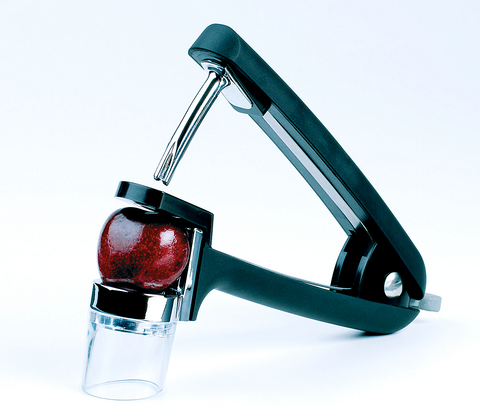Behold the Annoy-o-tron. The easy-to-hide magnetized device promises to drive a co-worker insane.
"The Annoy-o-tron generates a short (but very annoying, hence the name) beep every few minutes," assures the sales copy from ThinkGeek, its maker, which says it has sold 6,000 of the US$10 practical-joke gadgets online since December.
"It is very annoying," confirmed Jennifer Kuropkat, a ThinkGeek spokeswoman, who was a victim of the Annoy-o-tron during its testing phase. After three days of wondering where the brief ear-jangling sound — bzz-eee-eeep! — was coming from, she found the device hidden under her desk and managed to switch it off.

PHOTOS: NY TIMES NEWS SERVICE
Where have you gone, Garden Weasel?
As the popularity of that soil-cultivating device in the 1970s and of the Veg-O-Matic vegetable chopper in the 1960s attest, Americans have long been mad for silly devices promising to solve life's minor problems, even ones we didn't know we had.
And nowadays, from car to kitchen, from office to driving range, there is a profusion of gadgets that harness the latest micro technologies and the wackiest thinking of garage inventors. Whether the problem is how to one-up the office practical joker or brew a hot cup of espresso while driving to work, there's a gadget for it, and a cottage industry furiously bent on delivering more.

New and weird
"Every day there's something new and weird," said Adam Frucci, a writer for the gadget-chronicling blog Gizmodo. "A radio that floats in your bathtub and makes the water ripple with music, heated slippers that are warmed by USB, sneakers that have GPS built into them so parents can see where their kids are at all times by tracking them via satellite. It's a form of entertainment to see what sort of ridiculous stuff is put out there every day."
Lest you think gadgets are of minor interest to Americans, consider that Gizmodo and its main competitor, Engadget, both of which report news on forthcoming doodads serious, like mobile phones and notebook computers, as well as bizarre (a dog-powered scooter), are consistently ranked among the most popular blogs on the Internet. In February, they garnered a combined total of more than 1.6 million unique visitors, nearly double the same month a year earlier, according to comScore Media Metrix.

Many factors have come together to make this a golden age for gadgets. On the technological side, there is the increasing ease and decreasing cost of adapting technologies like USB, the low-voltage computer networking connection; the global positioning system; and Bluetooth to almost any use. On the marketing side, the home-shopping cable channels have 24 hours to fill, and, on a smaller scale, niche gadget retailers can easily set up Internet storefronts and pick up traffic from the gadget blogs.
Demographically, the aging baby boom generation, gadget-friendly since the days of the Pocket Fisherman, the foldable fishing rod and reel advertised on television, is discovering new uses for doohickeys that make life easier as boomers age. Meanwhile members of a younger generation are living time-pressed lives in bigger houses with counter space begging to be occupied.
Behind it all may be an impulse to escape. What gadget hounds are buying is a sense of control over their lives, said Ronni Eisenberg, an author of books about how to declutter. Even if they can't control their mortgage rate or the war in Iraq, gadget buyers can at least control a mango, thanks to a splitting and slicing device from Oxo, or unsightly nose hair, using a trimmer shaped like a finger sold by X-treme Geek. "We have a society where more is more, rather than less is more," Eisenberg said. "It's a sense of security, of comfort, of intrigue."
Low tech vs. high tech
Some new gadgets are high tech, like the T-shirt that plays an animation of the video game Pong; and some are low tech, like the jar spatula from Oxo, which is due in June. "Now you can access every last drop of mayonnaise!" the Oxo catalog promises of the small-headed silicone scraper.
Oxo, a kitchen-tool maker based in New York, is a success of the gadget age. It has thrived by marrying contemporary design with ergonomics and introducing an ever-widening line of gizmos like its Parmesan grater with a storage compartment to eliminate the chore of putting away cheese.
"People have a lot of little pet peeves," said Alex Lee, the company president. "And often they don't know they have them until you point it out to them."
When Brooke Stephens, an amateur chef, sees a new kitchen gadget on QVC, she tries repeating her mantra, "You really don't need this, you really don't need this." But often she caves. The drawers of her recently remodeled kitchen in Brooklyn, are so full she is now stuffing a hall closet with gadgets, among them a shrimp deveining knife and a marinade injector.
"I can always rationalize buying something by saying maybe one day I'll come across a recipe that might need that," she said. "It's nonsense. I know it!"
The success of the home shopping channels with their breathless hosts touting flashing dog tags and mop slippers ("walk your way to clean floors") spawned the ultimate tribute, a parody show, Home Purchasing Club. A recent episode featured two hosts extolling the virtues of the Bug Hammer, a rubber mallet with a target painted on one face to make squashing beetles a breeze.
The Internet is especially receptive to those who invent a better, or at least more colorful, mousetrap.
In Carmel, Indiana, an urban planner and home baker named Matthew Griffin invented a brownie pan that ingeniously makes every brownie have at least two crispy edges. "When we launched it we thought we had a niche product," Griffin said. "We liked corner brownies and were trying to create a new market, catering to the edge lover."
A few small blogs mentioned the pan last fall, and then Boingboing, a popular blog that often touts gadgets, ran an item last month. Traffic to the Baker's Edge Web site, previously averaging 6,000 hits a month, became as intense as a triple chocolate brownie. "We did 1,000 hits an hour for two weeks," Griffin said. His small company is sold out of the US$34 pans for now. Next in the development pipeline: an all-edge lasagna pan.
Not that the big boys have given up on the gadget game. Black & Decker, seller of the DustBuster, a seminal gadget introduced in 1979, is set to release in May the Lids Off automatic jar opener, designed for those whose grip is no longer sure enough to unseal jars of gourmet elderberry jam. The US$40 whirring Lids Off, big as a breadbox, is aimed at people, according to the product literature, who are "struggling from hand ailments or just struggling to escape the otherwise monotonous task of opening jars."
'The ultimate parody of modern society'
Some of the most sublimely ridiculous gadgets are designed to appeal to a younger set who spend hours in front of computers. The Dream Cheeky USB Missile Launcher plugs into a computer's USB port. A few mouse clicks aim and fire soft foam darts capable of clearing cubicle walls. A USB Hamster Wheel uses keystrokes to set a toy rodent scurrying nowhere, "the ultimate parody of modern society," an online retailer notes.
Going gadget ga-ga can lead to problems that no gadget can solve. Sarah Lazarovic, a photographer in Toronto, said she rues the day she bought a trick camera lens from a Russian dealer on the Internet that turned out to be uselessly cumbersome. "I've tried to stop buying useless stuff I'm never going to use, like periscope camera lenses," Lazarovic said. "I'm not proud of the whole box of cords and digital detritus I have."
Eisenberg, the clutter expert, suggested a low-tech solution to gadget overload. "The good thing is you can go through your apartment, gather them up and have a tag sale," she said by cell phone. "Pass them on to someone else."
Not every gadget is useless. The Annoy-o-tron works. An informal test on an unsuspecting newspaper reporter yielded a slow-rising boil of annoyance, starting with the question "What is that annoying sound?" and cresting, about 18 hours later, with cursing, a furious hunt, the device's discovery and a brutal stomping on it.
It survived.
Bzz-eee-eeep!

Taiwan doesn’t have a lot of railways, but its network has plenty of history. The government-owned entity that last year became the Taiwan Railway Corp (TRC) has been operating trains since 1891. During the 1895-1945 period of Japanese rule, the colonial government made huge investments in rail infrastructure. The northern port city of Keelung was connected to Kaohsiung in the south. New lines appeared in Pingtung, Yilan and the Hualien-Taitung region. Railway enthusiasts exploring Taiwan will find plenty to amuse themselves. Taipei will soon gain its second rail-themed museum. Elsewhere there’s a number of endearing branch lines and rolling-stock collections, some

The Democratic Progressive Party (DPP), Chinese Nationalist Party (KMT), and the country’s other political groups dare not offend religious groups, says Chen Lih-ming (陳立民), founder of the Taiwan Anti-Religion Alliance (台灣反宗教者聯盟). “It’s the same in other democracies, of course, but because political struggles in Taiwan are extraordinarily fierce, you’ll see candidates visiting several temples each day ahead of elections. That adds impetus to religion here,” says the retired college lecturer. In Japan’s most recent election, the Liberal Democratic Party lost many votes because of its ties to the Unification Church (“the Moonies”). Chen contrasts the progress made by anti-religion movements in

Could Taiwan’s democracy be at risk? There is a lot of apocalyptic commentary right now suggesting that this is the case, but it is always a conspiracy by the other guys — our side is firmly on the side of protecting democracy and always has been, unlike them! The situation is nowhere near that bleak — yet. The concern is that the power struggle between the opposition Chinese Nationalist Party (KMT) and their now effectively pan-blue allies the Taiwan People’s Party (TPP) and the ruling Democratic Progressive Party (DPP) intensifies to the point where democratic functions start to break down. Both

This was not supposed to be an election year. The local media is billing it as the “2025 great recall era” (2025大罷免時代) or the “2025 great recall wave” (2025大罷免潮), with many now just shortening it to “great recall.” As of this writing the number of campaigns that have submitted the requisite one percent of eligible voters signatures in legislative districts is 51 — 35 targeting Chinese Nationalist Party (KMT) caucus lawmakers and 16 targeting Democratic Progressive Party (DPP) lawmakers. The pan-green side has more as they started earlier. Many recall campaigns are billing themselves as “Winter Bluebirds” after the “Bluebird Action”